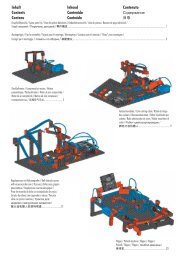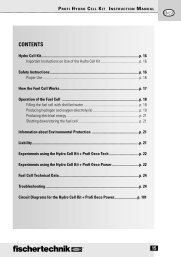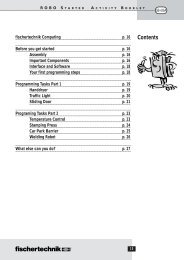computing - Fischertechnik
computing - Fischertechnik
computing - Fischertechnik
You also want an ePaper? Increase the reach of your titles
YUMPU automatically turns print PDFs into web optimized ePapers that Google loves.
COMPUTING<br />
Encoder Motors<br />
5<br />
ROBO TX Training Lab<br />
We use the two encoder motors, which are contained in the construction set, as the drive for our robots. At first<br />
glance, these are normal electric motors, which are designed for a voltage of nine volts and current input of a maximum<br />
of 0.5 amperes.<br />
But the encoder motors can do still more: In addition to the connection for the power supply for the motor, they have<br />
another jack socket for a three-pin connection cable and through this and with the aid of what is called the encoder,<br />
the rotational movement of the motor can be evaluated.<br />
The encoder functions similar to the speedometer on a bicycle. A magnet (in most cases for a bicycle located on one<br />
of the spokes) passes by a sensor (attached to the fork of the bicycle in most cases) with each revolution and the<br />
sensor generates a pulse due to this. These pulses can be counted, and, for example, multiplied with the circumference<br />
of the tire for the speedometer. In this way, the distance traveled is obtained.<br />
The encoders on the fischertechnik encoder motors generate three pulses with each revolution of the motor shaft.<br />
And because the encoder motors also have a gearbox with a transmission ratio of 25:1 (meaning "25 to 1"), then<br />
one revolution of the shaft, which comes out of the gearbox, corresponds to 75 pulses of the encoder.<br />
XS Motor<br />
The XS motor is an electric motor, which is exactly as long and high as a fischertechnik building block. In addition, it<br />
is very light. Due to this, you can install it at points, which do not have enough space for the big motors.<br />
Both gearboxes, which are also included in the construction set, fit exactly on the XS motor.<br />
The XS motor is designed for a supply voltage of nine volts and a current consumption of a maximum of 0.3<br />
amperes.<br />
Bulb<br />
Two bulbs are contained in the construction set. They can be used very multifariously, for example, as signal lights<br />
for a traffic light or as a blinking light on a robot.<br />
The bulbs are designed for a voltage of nine volts and consume about 0.1 amperes of current.<br />
Lens Tip Lamp<br />
A lens is a part of this lamp and this focuses the light. It looks very similar to the bulb lamp. You must be careful that<br />
you don't mistake one for the other. To make it easier to see the difference, the plug base for this lamp is gray, but the<br />
bulb lamp has a white plug base. You need the lens tip lamp to build a light barrier.<br />
The lens tip lamp is, as are the bulbs, designed for a voltage of nine volts and consumes about 0.15 amperes of<br />
current.<br />
Sensors<br />
Sensors are so to speak the counterpart to the actuators. This is because they do not perform any actions, but react<br />
to certain situations and events. For example, a pushbutton, reacts to the "pushing of the button" by allowing an<br />
electric current to pass or by interrupting it. A heat sensor reacts to the temperature in its surroundings.<br />
Phototransistor<br />
You can also call the phototransistor a "brightness sensor." This is a "sensor" that reacts to brightness.<br />
For a light barrier, this is the counterpart to the lens tip lamp. When there is a high degree of brightness, that is when<br />
the transistor receives light from the lens tip lamp, it conducts electricity. If the light beam is interrupted, the transistor<br />
does not conduct any electricity.<br />
Caution!<br />
When connecting the phototransistor to the power supply, you must pay special attention to the right polarity.<br />
The positive pole must be connected to the red marking on the phototransistor.











